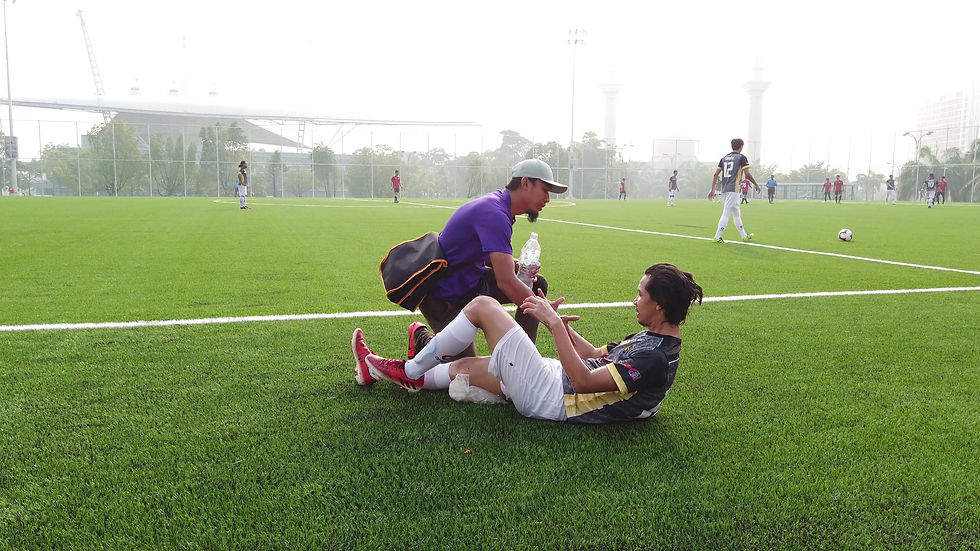MON, WED, FRI 8:00 AM - 6:00 PM
SATURDAY 8:00 AM - 1:00 PM
Sports Injury Treatment
Whether you’re a weekend warrior or a competitive athlete, you're likely to suffer a sports injury at some time in your life. Some of those injuries are obvious; the ones that occur immediately after a specific action or trauma. Like spraining your ankle while running, twisting you knee while skiing, or taking an awkward hit playing football. But most sports injuries are actually overuse injuries, and are not so obvious. These are the ones that can sneak up on you, and become a chronic, painful condition.
How you choose to treat your sports injury can affect how fast and how fully you recover from it. And also whether that injury will come back to haunt you later on. Even with a minor injury, it's important you seek proper treatment. Physical activity is not only enjoyable, but an important part of a healthy life style. Don't let a sports injury take the fun out of it. Schedule an appointment with Dr. McGahey and get back to doing what you love... without pain.

Types Of Sports Injury
Most sports injuries fall into one of just a few categories:
1. Pulled Muscle / Muscle Strain
This common injury occurs when a muscle can’t keep up with demand, or is stretched beyond its limits. It can range from mild to severe, and can be quite painful. Most people will suffer a pulled muscle at some point in their lives, especially if you're active.
2. Sprains
A sprain is an injury to a ligament, which is the thick, fibrous tissue that holds bones and joints together. Ligaments make joints strong and stable, but if stretched too far they can become injured (mild or moderate sprain) or even torn (severe sprain). This can cause the affected joint to become stiff and weak, or even unstable.
3. Tendonitis/Tendinosis
This is a painful, nagging injury that occurs when a tendon becomes inflamed from overuse. It's common with over-training, or performing repetitive movements, and usually becomes worse over time. Shoulders, elbows, hips and knees are common areas for this type of injury. And running, lifting, throwing and cycling are common causes.
4. Sports Injury From Contact Or Trauma
Unlike the first three injuries, which occur over time and with repetition, these sports injuries are one-time events. Collisions in contact sports, and falls during activities like skiing, snowboarding and other physical activities are prime examples.

Symptoms Related To Sports Injury
The symptoms of a sports injury vary depending on the type of injury you've suffered. More serious injuries tend to be one-time events. They can involve significant trauma, like a collision in a contact sports, or overextending a joint, like a sprained ankle or shoulder tear. These injuries can result in bruising, swelling, weakness, instability and loss of function. Some of these injuries involve broken bones, and some may need surgery or lengthy rehabilitation.
Luckily, most sports injuries fall into the repetitive use, or 'overuse' category. Hey, playing sports, and physical activity in general, is fun. But it can also take a toll on your body and can lead to nagging, chronic injuries. Overuse injuries like shins splints, IT band pain, plantar fasciitis from running, or shoulder and arm pain with throwing and hitting. These types of injuries usually involve symptoms like pain, ache, stiffness and tenderness to touch. You may find your pain, and other symptoms, get better as you warm up and start activity, but show up again later on like an old friend.

Effective Sports Injury Treatment
Most sports injuries are the result of overuse, or 'wear and tear'. That is, performing certain movements over and over again. These movements can be can quite forceful, and place a heavy demand on our joints and soft tissues. Explosive movements like throwing, kicking, hitting, lifting, running, and just about any physical activity, can lead to injury over time. What starts as stiff and sore muscles, can lead to joint stiffness, inflammation, scar tissue, or a worse injury later on.
If you have a sports injury, or pain and stiffness related to activity, don’t ignore the warning signs. By the time you feel symptoms, you could be creeping closer to a more serious condition. Chiropractic, and soft tissue therapies like Graston Technique or Active Release, are an effective combination for treating sports injuries. They can help reduce pain and inflammation, speed up healing, and reduce your risk of re-injury. That can help get you back in the game more quickly than passive therapies like bracing and rest.
What Are You Waiting For?
Don’t let an injury take the fun out of your activity. Dr. McGahey has been helping athletes, weekend warriors, and people who just want to feel better since 1998. Schedule an appointment today and get back in the game!
